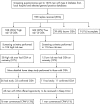Prevalence of obstructive sleep apnoea in men with type 2 diabetes
- PMID: 16928713
- PMCID: PMC2121154
- DOI: 10.1136/thx.2005.057745
Prevalence of obstructive sleep apnoea in men with type 2 diabetes
Abstract
Background: A study was undertaken to establish the prevalence of obstructive sleep apnoea (OSA) in men with type 2 diabetes.
Methods: Men with type 2 diabetes from local hospital and selected primary care practitioner databases received questionnaires about snoring, apnoeas, and daytime sleepiness based on the Berlin questionnaire. Selected respondents had overnight oximetry to establish whether they had OSA. Comparisons of oximetry were made with those from a previous general population study. HbA1c results were collected.
Results: 1682 men were sent questionnaires, 56% of whom replied. 57% scored as "high" and 39% as "low" risk for OSA; 4% were already known to have OSA. Oximetry was performed in 240 respondents from both risk groups: 31% of the "high" and 13% of the "low" risk group had significant OSA (more than 10 >4% Sao(2) dips/hour or Sao(2) tracing consistent with OSA). These results were verified by detailed sleep studies. Extrapolation of the oximetry data to the questionnaire respondent population suggests that 23% had OSA. Comparison of the oximetry results with men from a previous general population study (using only more than 10 >4% Sao(2) dips/hour to define OSA) showed the prevalence of OSA is significantly higher in this diabetes population (17% v 6%, p<0.001). Multiple linear regression revealed BMI and diabetes as significant independent predictors of OSA. Following correction for BMI (which explained 13% of the variance in OSA), diabetes explained a further 8% of the variance (p<0.001). There was a low correlation between OSA severity and HbA1c in the subgroup recruited from the hospital database (r = 0.2, p = 0.006) which remained significant after allowing for obesity (p = 0.03).
Conclusions: OSA is highly prevalent in men with type 2 diabetes; most are undiagnosed. Diabetes itself may be a significant independent contributor to the risk of OSA.
Conflict of interest statement
Competing interests: none.
Comment in
-
Diabetes and sleep apnoea: a hidden epidemic?Thorax. 2006 Nov;61(11):928-9. doi: 10.1136/thx.2006.062513. Thorax. 2006. PMID: 17071832 Free PMC article.
-
Screening for type 2 diabetes in patients with obstructive sleep apnoea.Thorax. 2007 Jul;62(7):651. Thorax. 2007. PMID: 17600297 Free PMC article. No abstract available.
References
Publication types
MeSH terms
LinkOut - more resources
Full Text Sources
Medical

